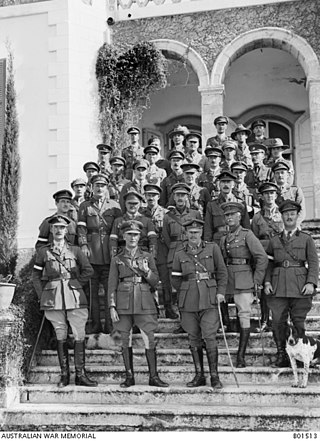
The Desert Mounted Corps was an army corps of the British Army during the First World War, of three mounted divisions renamed in August 1917 by General Edmund Allenby, from Desert Column. These divisions which served in the Sinai and Palestine Campaign had been formed by Australian light horse, British yeomanry, and New Zealand mounted rifles brigades, supported by horse artillery, infantry and support troops. They were later joined by Indian cavalry and a small French cavalry detachment.

The Battle of Megiddo was fought between 19 and 25 September 1918, on the Plain of Sharon, in front of Tulkarm, Tabsor and Arara in the Judean Hills as well as on the Esdralon Plain at Nazareth, Afulah, Beisan, Jenin and Samakh. Its name, which has been described as "perhaps misleading" since very limited fighting took place near Tel Megiddo, was chosen by British commander Edmund Allenby for its biblical and symbolic resonance.
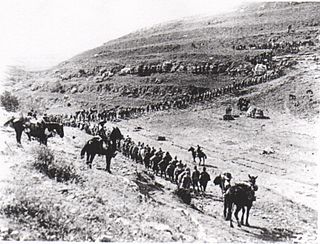
The First Transjordan attack on Amman and to their enemy as the First Battle of the Jordan took place between 21 March and 2 April 1918, as a consequence of the successful Battle of Tell 'Asur which occurred after the Capture of Jericho in February and the Occupation of the Jordan Valley began, during the Sinai and Palestine Campaign of World War I. During the First Transjordan attack large incursions into Ottoman territory occurred. Firstly the Passage of the Jordan River, was successfully captured between 21 and 23 March, followed by the first occupation of Es Salt in the hills of Moab between 24 and 25 March. The First Battle of Amman took place between 27 and 31 March when the Anzac Mounted Division and the Imperial Camel Corps Brigade were reinforced by two battalions of 181st Brigade followed by a second two battalions from the 180th Brigade and artillery. The Fourth Army headquarters located in Amman was strongly garrisoned and during the battle received reinforcements on the Hejaz railway, the strength of which eventually forced the attacking force to retire back to the Jordan Valley between 31 March and 2 April. The Jordan Valley would continue to be occupied by the Egyptian Expeditionary Force (EEF) through the summer until the middle of September 1918 when the Battle of Megiddo began.
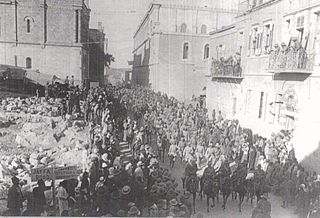
The Second Transjordan attack on Shunet Nimrin and Es Salt, officially known by the British as the Second action of Es Salt and by others as the Second Battle of the Jordan, was fought east of the Jordan River between 30 April and 4 May 1918, during the Sinai and Palestine Campaign of the First World War. The battle followed the failure of the First Transjordan attack on Amman fought at the beginning April. During this second attack across the Jordan River, fighting occurred in three main areas. The first area in the Jordan Valley between Jisr ed Damieh and Umm esh Shert the Egyptian Expeditionary Force (EEF) defended their advanced position against an attack by units of the Seventh Army based in the Nablus region of the Judean Hills. The second area on the eastern edge of the Jordan Valley where the Ottoman Army garrisons at Shunet Nimrin and El Haud, on the main road from Ghoraniyeh to Amman were attacked by the 60th (London) Division many of whom had participated in the First Transjordan attack. The third area of fighting occurred after Es Salt was captured by the light horse brigades to the east of the valley in the hills of Moab, when they were strongly counterattacked by Ottoman forces converging on the town from both Amman and Nablus. The strength of these Ottoman counterattacks forced the EEF mounted and infantry forces to withdraw back to the Jordan Valley where they continued the Occupation of the Jordan Valley during the summer until mid September when the Battle of Megiddo began.
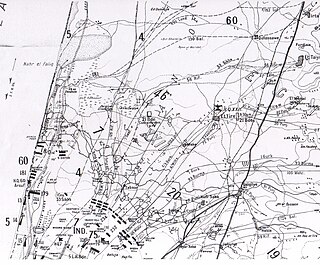
The Battle of Sharon fought between 19 and 25 September 1918, began the set piece Battle of Megiddo half a day before the Battle of Nablus, in which large formations engaged and responded to movements by the opposition, according to pre-existing plans, in the last months of the Sinai and Palestine Campaign of World War I. The fighting took place over a wide area from the Mediterranean Sea east to the Rafat salient in the Judean Hills. Here the Egyptian Expeditionary Force (EEF) XXI Corps with the French brigade sized Détachement Français de Palestine et de Syrie attacked the Yildirim Army Group Eighth Army's XXII Corps and German Asia Corps. The Battle of Sharon extended well behind the Ottoman front lines when the Desert Mounted Corps rode through a gap in the front line across the Plain of Sharon to occupy the Esdraelon Plain. Meanwhile, during the Battle of Nablus the XX Corps attacked Nablus while Chaytor's Force held the right flank in the Jordan Valley before advancing to secure bridges and fords across the Jordan River, to continue the encirclement the defenders in the Judean Hills. Subsequently, Chaytor's Force advanced against the Fourth Army to capture Es Salt and Amman after the Second Battle of Amman.

The Battle of Samakh was fought on 25 September 1918, during the Battle of Sharon which together with the Battle of Nablus formed the set piece Battle of Megiddo fought from 19 to 25 September 1918, in the last months of the Sinai and Palestine Campaign of the First World War. During the cavalry phase of the Battle of Sharon the Desert Mounted Corps commanded by the Australian Lieutenant General Harry Chauvel, captured the Esdraelon Plain 40–50 miles (64–80 km) behind the front line in the Judean Hills on 20 September, when the 3rd Light Horse Brigade captured Jenin. The 4th Light Horse Brigade, Australian Mounted Division was deployed guarding supply columns, and prisoners, before being ordered to attack and capture Samakh on the shore of the Sea of Gallilee. Here the Ottoman and German garrison had been ordered by the commander of the Yildirim Army Group to fight to the last man.
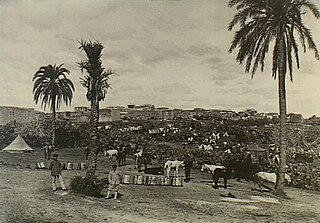
The Battle of Tulkarm took place on 19 September 1918, beginning of the Battle of Sharon, which along with the Battle of Nablus formed the set piece Battle of Megiddo fought between 19 and 25 September in the last months of the Sinai and Palestine Campaign of the First World War. During the infantry phase of the Battle of Sharon the British Empire 60th Division, XXI Corps attacked and captured the section of the front line nearest the Mediterranean coast under cover of an intense artillery barrage including a creeping barrage and naval gunfire. This Egyptian Expeditionary Force (EEF) victory over the entrenched Ottoman Eighth Army, composed of German and Ottoman soldiers, began the Final Offensive, ultimately resulting in the destruction of the equivalent of one Ottoman army, the retreat of what remained of two others, and the capture of many thousands of prisoners and many miles of territory from the Judean Hills to the border of modern-day Turkey. After the end of the battle of Megiddo, the Desert Mounted Corps pursued the retreating soldiers to Damascus, six days later. By the time an Armistice of Mudros was signed between the Allies and the Ottoman Empire five weeks later, Aleppo had been captured.
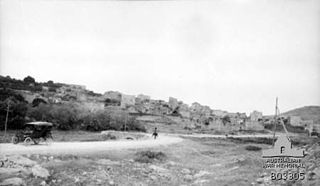
The Battle of Tabsor was fought on 19–20 September 1918 beginning the Battle of Sharon, which along with the Battle of Nablus formed the set piece Battle of Megiddo fought between 19 and 25 September in the last months of the Sinai and Palestine Campaign of the First World War. During the infantry phase of the Battle of Sharon the British Empire 60th Division, XXI Corps attacked and captured the section of the front line nearest the Mediterranean coast under cover of an intense artillery barrage including a creeping barrage and naval gunfire. This Egyptian Expeditionary Force (EEF) victory over the entrenched Ottoman Eighth Army, composed of German and Ottoman soldiers, began the Final Offensive, ultimately resulting in the destruction of the equivalent of one Ottoman army, the retreat of what remained of two others, and the capture of many thousands of prisoners and many miles of territory from the Judean Hills to the border of modern-day Turkey. After the end of the battle of Megiddo, the Desert Mounted Corps pursued the retreating soldiers to Damascus, six days later. By the time the Armistice of Mudros was signed between the Allies and the Ottoman Empire five weeks later, Aleppo had been captured.

The Battle of Nazareth began on 20 September 1918, during the Battle of Sharon, which together with the Battle of Nablus formed the set piece Battle of Megiddo fought during the last months of the Sinai and Palestine Campaign of the First World War. During the cavalry phase of the Battle of Sharon the Desert Mounted Corps rode to the Esdraelon Plain 40 and 50 miles behind the front line in the Judean Hills. At Nazareth on the plain, the 13th Cavalry Brigade of the 5th Cavalry Division attempted to capture the town and the headquarters of the Yildirim Army Group which was eventually captured the following day after the garrison had withdrawn.
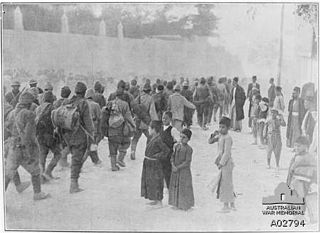
The Battle of Nablus took place, together with the Battle of Sharon during the set piece Battle of Megiddo between 19 and 25 September 1918 in the last months of the Sinai and Palestine Campaign of the First World War. Fighting took place in the Judean Hills where the British Empire's XX Corps attacked the Ottoman Empire's Yildirim Army Group's Seventh Army defending their line in front of Nablus. This battle was also fought on the right flank in the Jordan Valley, where Chaytor's Force attacked and captured the Jordan River crossings, before attacking the Fourth Army at Es Salt and Amman capturing many thousands of prisoners and extensive territory. The Battle of Nablus began half a day after the main Battle of Sharon, which was fought on the Mediterranean section of the front line where the XXI Corps attacked the Eighth Army defending the line in front of Tulkarm and Tabsor and the Desert Mounted Corps which rode north to capture the Esdrealon Plain. Together these two battles, known as the Battle of Megiddo, began the Final Offensive of the war in the Sinai and Palestine campaign.

The Capture of Damascus occurred on 1 October 1918 after the capture of Haifa and the victory at the Battle of Samakh which opened the way for the pursuit north from the Sea of Galilee and the Third Transjordan attack which opened the way to Deraa and the inland pursuit, after the decisive Egyptian Expeditionary Force (EEF) victory at the Battle of Megiddo during the Sinai and Palestine Campaign of World War I. Damascus was captured when Desert Mounted Corps and Prince Feisal's Sherifial Hejaz Army encircled the city, after a cavalry pursuit northwards along the two main roads to Damascus. During the pursuit to Damascus, many rearguards established by remnants of the Ottoman Fourth, Seventh and Eighth Armies were attacked and captured by Prince Feisal's Sherifial Army, Desert Mounted Corps' Australian Mounted Division the 4th and the 5th Cavalry Divisions. The important tactical success of capturing Damascus resulted in political manoeuvring by representatives from France, Britain and Prince Feisal's force.
The Third Transjordan attack by Chaytor's Force, part of the British Empire's Egyptian Expeditionary Force (EEF), took place between 21 and 25 September 1918, against the Ottoman Empire's Fourth Army and other Yildirim Army Group units. These operations took place during the Battle of Nablus, part of the Battle of Megiddo which began on 19 September in the final months of the Sinai and Palestine Campaign of World War I. Fought on the right flank and subsidiary to the Battle of Nablus, the Third Transjordan attack began northwards, with the assault on Kh Fasail. The following day a section of Chaytor's Force, attacked and captured the Ottoman Empire's 53rd Division on the main eastwards line of retreat out of the Judean Hills across the Jordan River. Retreating columns of the Yildirim Army Group were attacked during the battle for the Jisr ed Damieh bridge, and several fords to the south were also captured, closing this line of retreat. Leaving detachments to hold the captured bridge and fords, Chaytor's Force began their eastwards advance by attacking and capturing the Fourth Army garrison at Shunet Nimrin on their way to capture Es Salt for a third time. With the Fourth Army's VIII Corps in retreat, Chaytor's Force continued their advance to attack and capture Amman on 25 September during the Second Battle of Amman. Several days later, to the south of Amman, the Fourth Army's II Corps which had garrisoned the southern Hejaz Railway, surrendered to Chaytor's Force at Ziza, effectively ending military operations in the area.
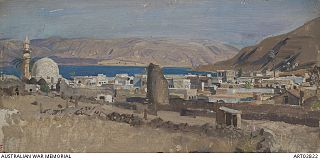
The Capture of Tiberias took place on 25 September 1918 during the Battle of Sharon which together with the Battle of Nablus formed the set piece Battle of Megiddo fought between 19 and 25 September in the last months of the Sinai and Palestine Campaign of the First World War. During the cavalry phase of the Battle of Sharon the Desert Mounted Corps occupied the Esdraelon Plain 40–50 miles (64–80 km) behind the front line in the Judean Hills. One squadron from each of the 3rd and 4th Light Horse Brigades Australian Mounted Division attacked and captured Tiberias, along with the Yildirim Army Group's Ottoman and German garrison.

The Pursuit to Haritan occurred between 29 September and 26 October 1918 when the XXI Corps and Desert Mounted Corps of the Egyptian Expeditionary Force (EEF) pursued the retreating remnants of the Yildirim Army Group advanced north from Damascus after that city was captured on 1 October during the final weeks of the Sinai and Palestine Campaign of the First World War. The infantry and corps cavalry advanced from Haifa and Acre to capture the Mediterranean ports at Beirut and Tripoli between 29 September and 9 October. These captures enabled the inland pursuit to be supplied when the Desert Mounted Corps' 5th Cavalry Division resumed the pursuit on 5 October. The cavalry division occupied one after the other, Rayak, Homs, Hama. Meanwhile, Prince Feisal's Sherifial Force which advanced on the cavalry division's right flank, attacked and captured Aleppo during the night of 25/26 October after an unsuccessful daytime attack. The next day the 15th Cavalry Brigade charged a retreating column and attacked a rearguard during the Charge at Haritan near Haritan which was at first reinforced but subsequently withdrew further north.
Chaytor's Force named after its commander, Major General Edward Chaytor, was a composite division-sized force which served in the British Egyptian Expeditionary Force during the Sinai and Palestine Campaign of the First World War. The force of 11,000 men, consisted of a division headquarters, three mounted and one infantry brigades, four independent infantry battalions and four artillery batteries and was detached from the Desert Mounted Corps for deception operations.
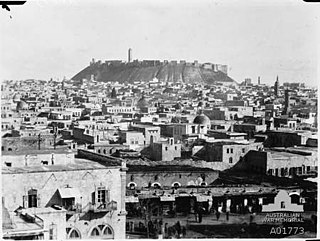
The Battle of Aleppo was fought on 25 October 1918, when Prince Feisal's Sherifial Forces captured the city during the Pursuit to Haritan from Damascus, in the last days of the Sinai and Palestine Campaign in the First World War.

The First Battle of Amman was fought from 27 to 31 March 1918 during the First Transjordan attack on Amman of the Sinai and Palestine Campaign of the First World War. The 60th (London) Division and the Anzac Mounted Division attacked the Ottoman garrison at Amman deep in enemy occupied territory, 48 kilometres (30 mi) from their front line, after capturing Es Salt and Shunet Nimrin. The Egyptian Expeditionary Force (EEF) was successfully counterattacked by Ottoman Empire forces forcing them to retreat back to the bridgeheads captured on the Jordan River.

The Second Battle of Amman was fought on 25 September 1918 during the Third Transjordan attack as part of the Battle of Nablus which together with the main Battle of Sharon form the major set piece offensive known as the Battle of Megiddo of the Sinai and Palestine Campaign in World War I. After cutting the road from Nablus to Es Salt on 22 September Chaytor's Force captured the bridge over the Jordan River at Jisr ed Damieh while units of the Seventh Army and remnants of the Eighth Army were still in retreating towards the bridge from the Judean Hills. Having cut this line of retreat, Chaytor's Force proceeded eastwards to attack and capture Es Salt, before riding on to attack and capture the Ottoman rearguard of the Fourth Army defending Amman. These British Empire victories of the Third Transjordan attack over Yildirim Army Group forces, followed two unsuccessful EEF attacks across the Jordan River in March and April 1918.
The Southern Palestine offensive, began on 31 October 1917, with the Battle of Beersheba, when the British Empire's Egyptian Expeditionary Force (EEF) under the Command of Field Marshall Edmund Allenby attacked Ottoman Empire forces at the Palestinian town of Beersheba during the Sinai and Palestine Campaign, of World War I. After the capture of Beersheba, by the EEF, the Gaza to Beersheba line became increasingly weakened and, seven days later, the EEF successfully forced the Ottoman Turkish Empire's Seventh and Eighth Armies to withdraw. During the following seven days of pursuit, the Turkish forces were pushed back to Jaffa. There followed three weeks of hard fighting in the Judean Hills before Jerusalem was captured on 9 December 1917. During five and a half weeks of almost continuous offensive operations, the EEF captured 47.5 miles (76.4 km) of territory.
The Structure of the Egyptian Expeditionary Force over the course of the First World War is shown below.















